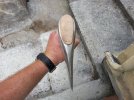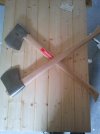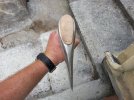I think that thicker bitted axes just need to be used with more of a chip-popping method because of the increased side-load it's able to generate. It limits the depth of the blow, but increases the splitting force, so a thicker bit will pop a chip a lot easier than a narrow-bitted axe, which works best by paring material from the sides of the notch. Different designs for different methods, and judging one design on the characteristics of the other would give a fellow a poor opinion of the tool.
Thunderstick--the OP did not say specifically the shape of the eye in question, and it seems to be actually indicating slip-fit vs. wedge fit rather than eye
shape. Slip-fit axes and hammers are still quite common in Italy and France, and made both domestically and by foreign nations for French and Italian markets. A slip-fit handle is NOT easier to make because you
have to thin the entire length sufficiently to pass through the eye. It does increase packability and decreases dependence on other tools, as well as allowing the same head to be used with multiple handles (for instance, a short handle for crafting and a long handle for felling or splitting.) It's true that a thin bit is a poor splitter, but that has
less to do with the
eye design and more to do with the
bit design. Take a given eye on paper and you can draw a bit to contain it that transitions smoothly.
As far as the swell issue, it depends on the size and style of the particular eye. In the case of the Calabria axes a fore/aft flare can be a viable solution, even though a lateral one is less so. This isn't much different from inexpensive conventional wedged handles that use saw-cut flat forms rather than lathe-turned. Zero side flare, but the presence of a fore/aft one. I did such with my personal 700g Calabria.










